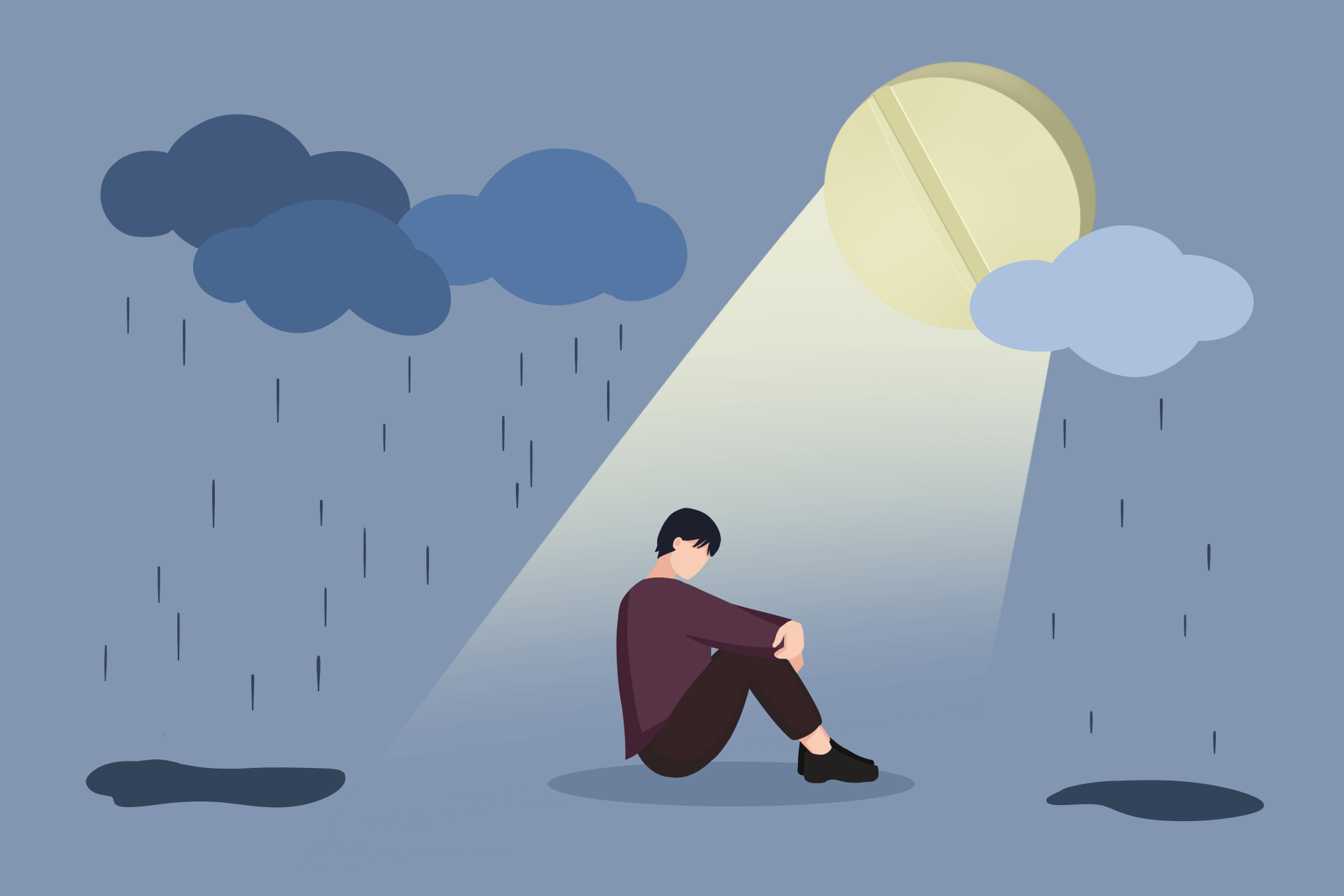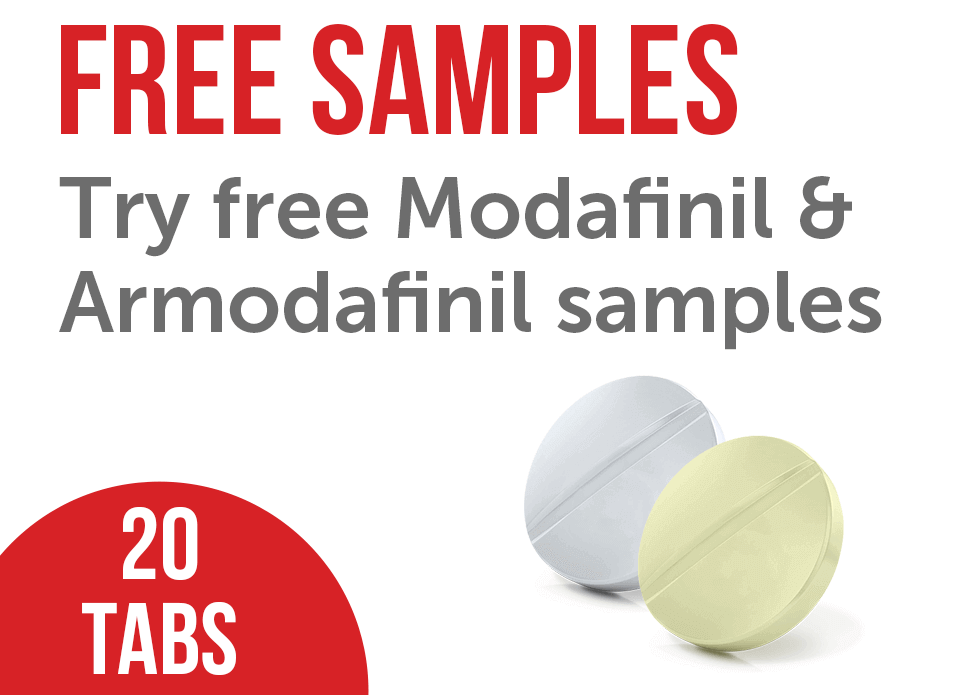Armodafinil, an eugeroic med comprehended for its wakefulness-fostering properties, has made significant strides since its introduction to the market. Initially designed to combat excessive daytime sleepiness, armodafinil has found an unexpected yet noteworthy role in the realm of mental health, particularly in treating depression. Its ability to upgrade cognitive function, improve alertness, and elevate mood has made it a valuable tool not just for those with sleep disorders, but also for people facing the debilitating effects of depression.
This guide provides an in-depth look at the use of armodafinil for depression, covering everything from its pharmacological profile, correct dosages, proven benefits, and potential side effects to its practical application in managing depressive symptoms. Let’s dive in.
Key About Armodafinil
Armodafinil, marketed under the brand name Nuvigil, is a wakefulness-fostering agent that acts as a central nervous system stimulant. It’s the R-enantiomer of modafinil, meaning it is a more potent med, allowing for lower dosages with similar efficacy. The FDA approved armodafinil med in June 2007 for the therapy of excessive sleepiness linked with narcolepsy, obstructive sleep apnea, as well as shift work disorder [1].
Armodafinil’s capability to heighten wakefulness and upgrade cognitive function has made it a popular choice for various off-label uses. These off-label applications include the remedy of depression, attention deficit hyperactivity disorder (ADHD), chronic fatigue syndrome, and as an adjunct therapy in bipolar disorder. It has also been explored for managing conditions such as multiple sclerosis-related fatigue, Parkinson’s & Alzheimer’s disease, weight loss, and jet lag. Additionally, its cognitive-enhancing effects have attracted attention in fields such as academia and professions demanding prolonged periods of alertness, concentration, mental acuity, boosted memory, heightened motivation & energy, augmented planning & decision-making skills, as well as upgraded fluid intelligence.
Depression Main Info
Depression (also known as major depressive disorder, major depression, or clinical depression) is indeed a common and serious mood disorder that significantly impacts an individual’s daily life. It affects how a person thinks, feels, and handles activities (e.g. eating, sleeping, or working), often leading to various emotional and physical problems. Comprehending the symptoms and available therapy methods is vital for efficacious management and recovery.
Symptoms of Depression
Depression manifests via a variety of symptoms that can vary in intensity and duration. Common manifestations include the following [2]:
- persistent sadness: A continuous feeling of sadness, emptiness, or hopelessness that lasts for most of the day, nearly every day;
- loss of interest or pleasure: A marked decrease in interest or pleasure in almost all activities, including hobbies and activities that were once enjoyed;
- changes in appetite: Significant weight loss or gain unrelated to dieting, or a noticeable decrease or increase in appetite;
- sleep disturbances: Insomnia or excessive sleeping (hypersomnia), both of which can contribute to feelings of fatigue and low energy;
- fatigue or loss of energy: Persistent tiredness and lack of energy that doesn’t improve with rest;
- feelings of worthlessness or guilt: Excessive or inappropriate feelings of guilt or worthlessness, often over minor or past events;
- cognitive difficulties: Trouble concentrating, making decisions, or remembering things; this can affect work or school performance;
- physical symptoms: Unexplained aches and pains, headaches, cramps, or digestive problems that don’t have a clear physical cause;
- psychomotor changes: Observable slowing down of thought and physical movement (psychomotor retardation) or increased purposeless physical activity (psychomotor agitation);
- suicidal thoughts: Recurrent thoughts of death, suicidal ideation, or suicide attempts; this is one of the most serious symptoms and requires immediate attention.
Identifying these symptoms is the first step toward pursuing help and a treatment plan. Take note that depression is a treatable condition, and with the right mix of therapies, patients can manage their symptoms and lead fulfilling lives. Nonetheless, seeking support from healthcare professionals, friends, and family can make a significant difference in overcoming the challenges posed by depression.
Methods of Treatment of Depression
Treating depression typically involves a multifaceted approach tailored to the individual’s needs. Effective management often combines medication, therapy, lifestyle changes, and sometimes alternative therapies [3][4].
Medications
- Antidepressants. These are the most common meds used to treat depression. They include:
- selective serotonin reuptake inhibitors (SSRIs): Such as fluoxetine, sertraline, and citalopram;
- serotonin-norepinephrine reuptake Inhibitors (SNRIs): Such as venlafaxine and duloxetine;
- atypical antidepressants: Such as bupropion and mirtazapine;
- tricyclic antidepressants (TCAs): Such as amitriptyline and nortriptyline are best used to manage and treat major depressive disorder (MDD). Tricyclics typically lead to more severe negative effects compared to newer antidepressants. Therefore, they are usually not prescribed unless an SSRI has been tried first and has not resulted in improvement;
- monoamine oxidase inhibitors (MAOIs): Such as phenelzine and tranylcypromine.
- Adjunctive meds. Sometimes other meds, such as mood stabilizers or antipsychotics, are added to enhance the effectiveness of antidepressants or address co-occurring conditions.
Psychotherapy
- cognitive-behavioral therapy (CBT): Focuses on identifying and changing negative thought patterns and behaviors;
- interpersonal therapy (IPT): Addresses interpersonal issues and aims to improve communication and relationship skills;
- dialectical behavior therapy (DBT): Combines CBT with mindfulness practices and is particularly effective for individuals with severe emotional regulation issues;
- psychodynamic therapy: Explores unconscious patterns and past experiences to understand current behavior and emotions.
Lifestyle Changes
- regular exercise: Physical activity improves mood and reduces symptoms of depression;
- healthy diet: Proper nutrition can affect mood and energy levels. A balanced diet is essential for overall well-being;
- adequate sleep: Establishing a regular sleep routine can help manage symptoms of depression;
- stress management: Techniques such as mindfulness, meditation, and relaxation exercises can reduce stress and improve mood.
Alternative Treatments
- acupuncture: Some find relief from depressive symptoms through acupuncture treatments.
- herbal supplements: St. John’s Wort and other supplements are sometimes used, but it’s vital to consult a healthcare provider before starting any supplement. Mixing St. John’s wort with certain antidepressants may cause a dangerous rise in serotonin levels in the body, which can be life-threatening. It’s important not to attempt self-treatment for depression [5];
- light therapy: Beneficial for seasonal affective disorder (SAD), light therapy involves exposure to a light box that mimics natural sunlight.
Electroconvulsive Therapy (ECT)
ECT is a procedure where small electric currents are passed through the brain, intentionally triggering a brief seizure. ECT can provide rapid relief for severe depression, especially when other treatments have failed.
Combining these therapy methods can provide a comprehensive approach to managing depression, helping individuals regain control over their lives and improve their overall quality of life.
Use of Armodafinil in Depression
Armodafinil has garnered interest as a potential treatment for depression, particularly as an adjunct therapy for individuals who have not responded adequately to traditional antidepressants. According to Drugs.com, armodafinil has received an average rating of 8.4 out of 10 based on 41 reviews for its off-label use in treating depression. 80% of the reviewers shared positive experiences, whereas 12% documented negative experiences [6]. Its unique properties and mechanism of action make it a valuable option for addressing some of the more challenging aspects of depression, such as fatigue, cognitive impairment, and low energy levels.
As a central nervous system stimulant, it works by altering the levels of certain neurotransmitters in the brain, such as dopamine, histamine, orexin, serotonin, and norepinephrine. These neurotransmitters play crucial roles in regulating mood, alertness, motivation, and cognitive function. Ultimately, by upgrading their activity, armodafinil helps to alleviate some of the symptoms of depression, specifically those linked to cognitive deficits and low energy.
Correct Dosage
A healthcare provider should determine the correct dosage of armodafinil for treating depression. The typical starting dosage ranges from 50 mg to 150 mg per day, taken in the morning to avoid interference with sleep. The dosage can be increased based on the patient’s response and tolerance, with a maximum recommended dose of 250 mg daily.
Armodafinil can be taken with or without food. To ensure the med is efficacious, it should be taken with a full glass of water. It‘s crucial to follow the healthcare provider’s instructions closely and not exceed the prescribed dosage without conferring with a doctor. Regular follow-up appointments are necessary to monitor the medication’s effectiveness and make any necessary adjustments.
Proven Benefits
Armodafinil has several benefits in the treatment of depression, particularly as an adjunct therapy. Some of the proven benefits include:
- enhanced wakefulness and alertness: Armodafinil’s primary function is to heighten wakefulness, making it efficacious in lessening excessive sleepiness. For individuals with depression who experience significant fatigue and lethargy, this can lead to improved daily functioning and productivity;
- upgraded cognitive function: Depression often impairs cognitive abilities, including memory, thinking, learning, mental acuity, concentration, and decision-making. Nonetheless, the med ameliorates cognitive performance, helping patients think more clearly and efficiently. This improvement in cognitive function can positively impact work, academic performance, and daily activities;
- Increased energy levels: The stimulating properties of armodafinil aid in boosting energy levels and combating the pervasive tiredness commonly associated with depression. Increased energy can encourage greater participation in physical activities, social interactions, and overall engagement with life;
- mood enhancement: Although not a traditional antidepressant, armodafinil’s effects on neurotransmitter activity can lead to mood improvement. Patients may experience a reduction in feelings of sadness and hopelessness, contributing to a more positive outlook;
- adjunctive therapy benefits: When used in combination with standard antidepressants, armodafinil can enhance the overall therapy response. Adding armodafinil to an existing antidepressant regimen can result in greater relief from depressive symptoms, specifically in individuals with treatment-resistant depression.
These proven benefits make armodafinil a valuable option for individuals struggling with depression, particularly those who haven’t found adequate relief from traditional therapies alone. Nevertheless, as with any medication, it’s fundamental to use armodafinil under the supervision of a physician to guarantee its safe and effective use.
Side Effects and Precautions
Armodafinil is safe and well-tolerated. However, it can cause some side effects like any med [7]. Common negative effects include dry mouth, nervousness, headache, nausea, dizziness, and difficulty sleeping. These effects are usually mild and transient, often fading away as the body adjusts to the medication. Contact your doctor if these persist or worsen. This med is prescribed because the benefits outweigh the risks. Most people do not experience serious negative effects.
Report serious negative effects to your doctor instantly, such as mental/mood changes (depression, hallucinations, agitation, confusion, suicidal thoughts), fast/irregular heartbeat, or chest pain. Also, seek medical help for severe allergic reactions, including fever, rash, itching/swelling (especially of the tongue/face/throat), swollen lymph nodes, severe dizziness, and trouble breathing.
Though helpful for many, armodafinil may lead to addiction, particularly if you have a history of substance abuse. To minimize this risk, take the med precisely as prescribed.
Before taking armodafinil, inform your doctor if you are allergic to it, modafinil, or other substances. Discuss your medical history, especially high blood pressure, heart problems, liver issues, mental/mood disorders, substance use disorders, seizure disorders, psychotic disorders, and renal dysfunction.
Armodafinil can interact with various drug classes, including stimulants, blood thinners, sedatives like triazolam and midazolam, monoamine oxidase inhibitors, meds metabolized by enzymes CYP2C19 and CYP3A4/5, birth control meds, certain antifungal drugs, and substances such as poppers or street drugs.
Armodafinil can impair quick reactions despite promoting wakefulness. Avoid driving or operating machinery until you can do so safely. Alcohol and marijuana can augment dizziness. Avoid alcohol and consult your physician if using marijuana. Inform your physician about all meds and supplements you are taking since it can interact with other meds changing how your meds work or augment your risk for serious negative effects.
Armodafinil may harm an unborn baby; avoid pregnancy while using it. Discuss reliable non-hormonal birth control options with your physician. If you become pregnant, inform your doctor immediately. Caffeine can amplify this med’s negative effects. Bypass consuming large quantities of caffeinated drinks (tea, coffee, colas), chocolate, or nonprescription caffeine products.
Besides, avoid consuming grapefruit and grapefruit juice. Grapefruit can interfere with the enzymes that metabolize armodafinil in the liver, potentially leading to higher levels of the med in the bloodstream. This can augment the peril of negative effects and affect the overall efficacy of the med. Discuss any dietary habits, including grapefruit consumption, with a physician to ensure armodafinil’s safe and efficacious use.
Armodafinil and Other Mood Disorders
Armodafinil, initially used for sleep disorders, shows promise in managing various mood disorders such as bipolar disorder, dysthymia, seasonal affective disorder (SAD), and others like anxiety disorders and major depressive disorder (MDD). Its wakefulness-promoting and cognitive-enhancing properties make it effective in alleviating depressive symptoms, improving energy levels, and enhancing motivation. Armodafinil can serve as an adjunctive treatment, particularly for bipolar depression, without triggering manic episodes [8]. While specific research on its use for dysthymia and SAD is limited, anecdotal evidence and smaller studies suggest significant benefits. Furthermore, Armodafinil reduces fatigue and cognitive dysfunction in MDD and shows potential in alleviating anxiety symptoms. Its positive effects on attention and executive function offer potential advantages for individuals with ADHD, especially those with coexisting mood disorders. In post-traumatic stress disorder (PTSD), it alleviates fatigue and enhances cognitive function, though its use requires further research.
Chronic fatigue syndrome, also known as Myalgic encephalomyelitis (ME/CFS), is characterized by extreme, unexplained fatigue that isn’t improved by rest. Although not a mood disorder per se, it often leads to mood disturbances like depression and anxiety. However, this med helps reduce fatigue and improve quality of life in individuals with CFS, thereby indirectly improving mood and overall mental health.
For dysthymia, cyclothymia, and hypomania, armodafinil helps lessen persistent fatigue and cognitive difficulties, improving daily functioning and quality of life. While promising for these mood disorders, armodafinil should be used under medical supervision to ensure safety and efficacy. Regular monitoring and dosage adjustments are essential to maximize its therapeutic benefits and minimize risks.
The Verdict: Armodafinil for Depression
Armodafinil offers a promising alternative or adjunctive treatment for individuals struggling with depression, especially for those who have not found relief with traditional antidepressants. Its ability to enhance wakefulness, improve mood, and boost cognitive function makes it a valuable addition to the arsenal of depression treatments. However, like all medications, it should be used with caution and under the supervision of a healthcare provider to ensure safety and efficacy. For those seeking new avenues for managing their depression, Armodafinil presents a compelling option worth considering.
References
- Armodafinil. Retrieved: July 28, 2024. Wikipedia.org.
- Depressive disorder (depression). Published: March 31, 2023. Who.int.
- Depression (major depressive disorder). Retrieved: July 28, 2024. Mayoclinic.org.
- What is depression and what can I do about it? By Laura Goldman. Medically reviewed by Nicole Washington. Medicalnewstoday.com.
- St. John’s Wort and Depression: In Depth. Retrieved: July 28, 2024. Nccih.nih.gov.
- Armodafinil for Depression User Reviews. Retrieved: July 28, 2024. Drugs.com.
- Armodafinil – Uses, Side Effects, and More. Retrieved: July 28, 2024. Webmd.com
- Long-term safety and efficacy of armodafinil in bipolar depression: A 6-month open-label extension study. By Terence A Ketter, Jess Amchin, Mark A Frye, Nicholas Gross. Published: February 27, 2016. Pubmed.ncbi.nlm.nih.gov.








